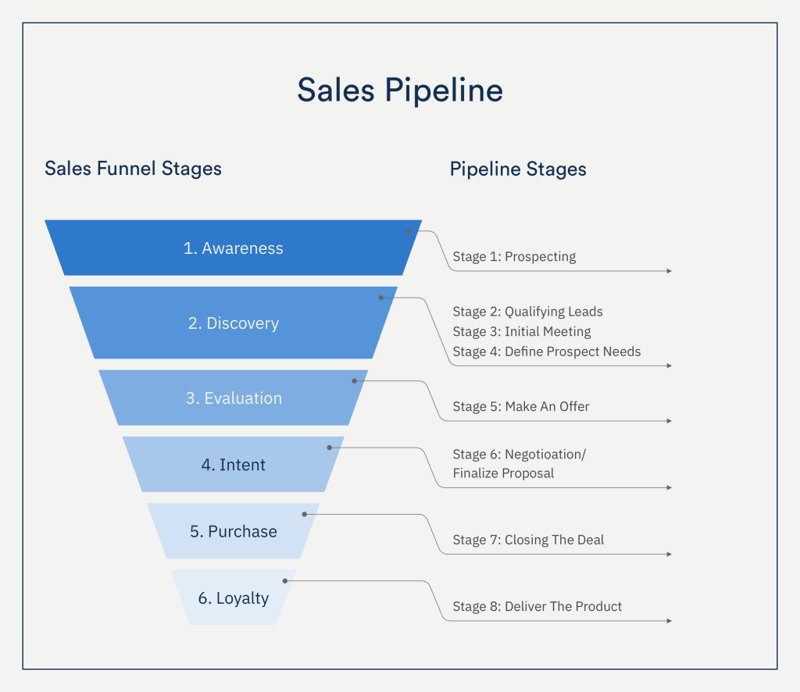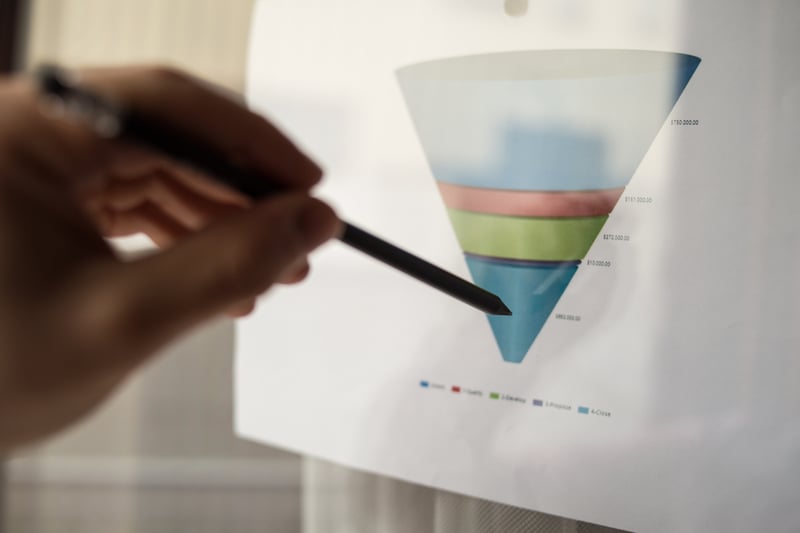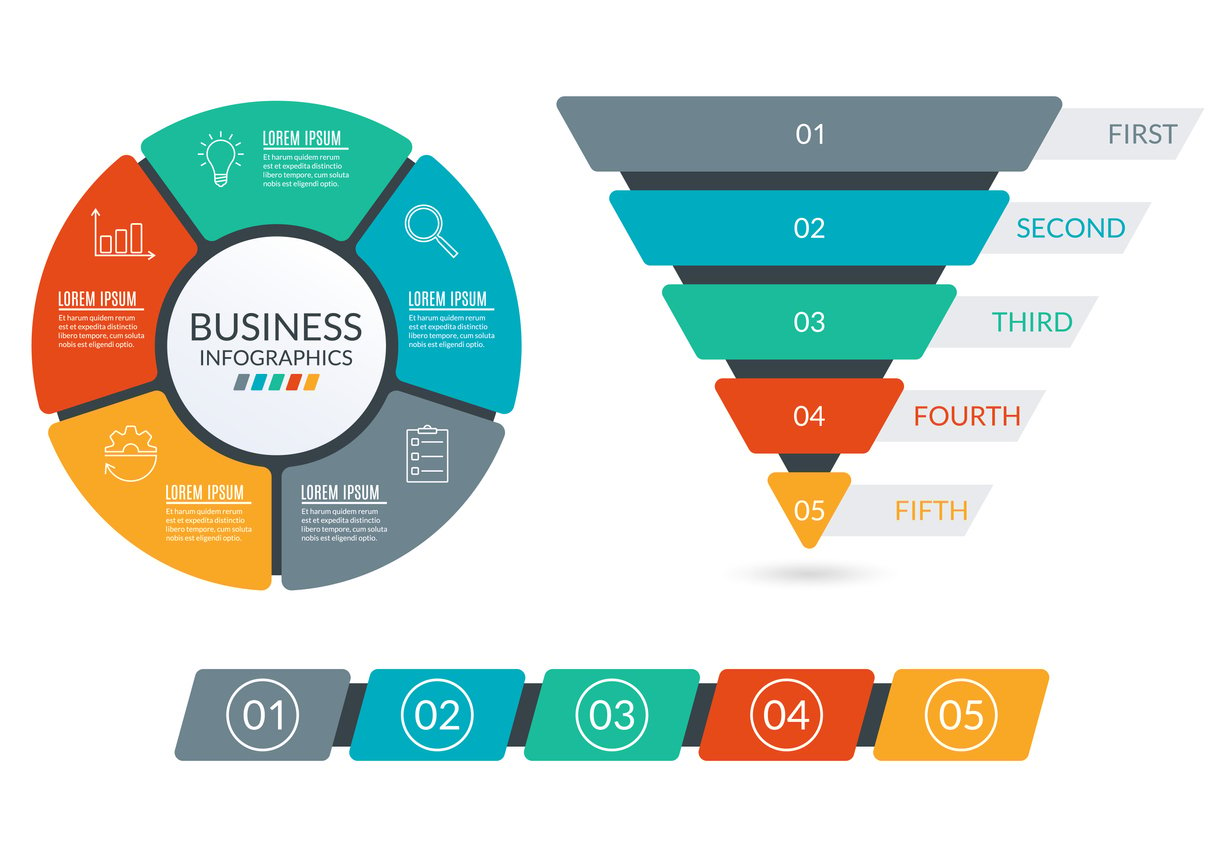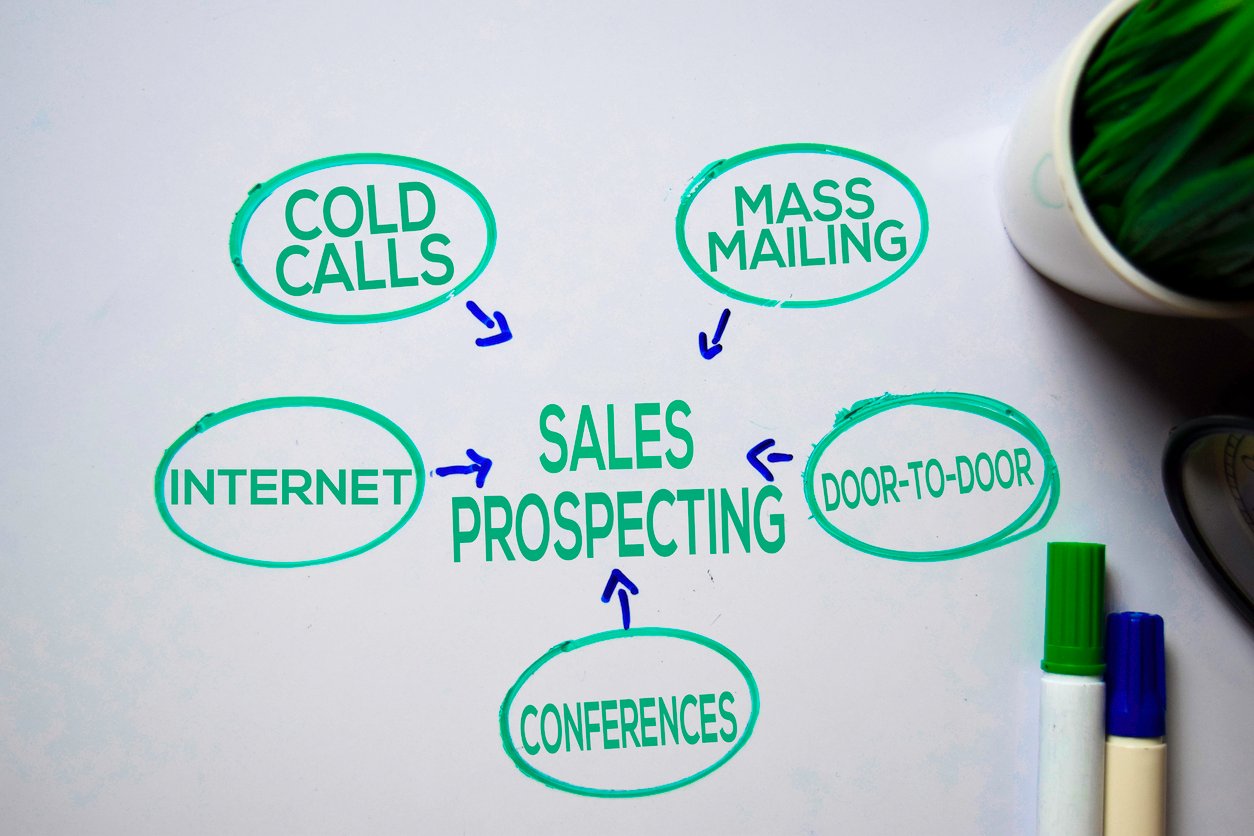
How to Build a Sales Pipeline [Step-By-Step Guide]
 Updated on
Updated on
 By Carlos Correa
By Carlos Correa
Carlos Correa
Carlos has been involved in the sales space for well over ten years. He began in the insurance space as an individual sales agent, managing teams as s...
learn more
Carlos Correa
Carlos has been involved in the sales space for well over ten years. He began in the insurance space as an individual sales agent, managing teams as s...
Table of Contents
Table of Contents
Do your salespeople really understand your company's sales process?
Do they follow it to the letter every single time, with every single sale?
What if there was an easy way to track not only the performance of your sales reps but also where each and every current lead lives in your sales process?
You can do it with a sales pipeline.
By the end of this article, you'll have a clear understanding of what a sales pipeline is, and just how essential of a tool it is to your sales team and the entire business.
Let's get started!
Sales Pipeline Definition
A sales pipeline allows salespeople to keep track of where leads or prospects are in their company's sales process. It also gives them a good understanding of their own sales performance, the company's sales performance, and where improvements can be made.
What is a Sales Pipeline?
A sales pipeline provides a visual representation of a company's sales process. The word pipeline might bring out pictures of a sewer or an itsy bitsy spider climbing a water spout, but a sales pipeline is more like a roadmap.
When you plan out a road trip, chances are you're highlighting stops along the way where you'll take a break to use the restroom or grab a bite to eat. A sales pipeline is similar; it maps out a customer's journey so that a salesperson can see where their customer is in the sales process, and engage with them accordingly.
That might mean sending an email, SMS, or giving them a call. Sales reps can also use pipelines to figure out whether they are meeting their sales goals.
In other words, with a pipeline sales process, sales reps can easily see where they are in terms of making their sales quotas for a given period, while at the same time keeping track of their assigned leads.
There's an oft-cited 2015 survey that was conducted by the Harvard Business Review that asked companies to self-evaluate their sales pipeline effectiveness using a scale of 1 to 7, with 1 being not great at all and 7 being excellent. Companies with ineffective pipeline management averaged a score of 4.6, while companies with effective pipeline management showed a growth rate of 5.3, which translates to a 15% increase in growth.
Companies that "mastered" their sales pipeline saw 28% revenue growth. While the article doesn't state how many companies were surveyed, the numbers given seem promising in terms of dedicating time to sales pipeline management best practices.
But before we get into the nitty-gritty of sales pipeline reporting, strategies, management, and more, it's important to understand how a sales pipeline matches up with the buyer's journey or sales funnel.
Sales Pipeline Versus a Sales Funnel
The sales pipeline and sales funnel go hand in hand. While the sales funnel outlines where a customer is in their buying journey, the sales pipeline determines how a salesperson should be engaging with the customer as they move through that buying journey.

|
Component |
Sales Pipeline |
Sales Funnel |
|
Focus |
How salespeople engage with customers. |
Where the customer is in their buying journey. |
|
Stage Breakdown |
Lead generation, qualification, engagement, closing. |
Awareness, Interest, Evaluation, Intent, Purchase, Loyalty. |
|
Primary Purpose |
Managing and progressing leads through sales stages. |
Understanding the customer's journey to purchase. |
|
Role of Salesperson |
Actively engages and manages leads. |
Focused on guiding the customer through the journey. |
Let's break it down for you in more detail below.
The Sales Funnel represents the entire customer journey from initial awareness to a completed purchase and beyond. It focuses on the stages a customer goes through.
- Awareness: Customer becomes aware of your brand.
- Interest: Customer shows interest in your product/service.
- Consideration: Customer evaluates your offerings against competitors.
- Decision: Customer decides to purchase.
- Purchase: Customer makes the purchase.
- Loyalty: Customer becomes a repeat customer.

On the other hand, the Sales Pipeline outlines the specific steps a salesperson takes to guide a customer through the sales funnel. It focuses on the actions and activities involved in closing a deal.
- Lead Generation: Identifying and acquiring potential customers.
- Lead Qualification: Determining if a lead is a good fit for your product/service.
- Needs Analysis: Understanding the customer's specific needs and pain points.
- Proposal/Presentation: Presenting your solution and its value to the customer.
- Negotiation: Discussing and agreeing on the terms of the sale.
- Closing: Securing the sale and finalizing the agreement.
- Onboarding/Delivery: Delivering the product/service and ensuring customer satisfaction.
In essence, the sales funnel maps the customer's journey, while the sales pipeline outlines the salesperson's roadmap to navigate that journey successfully.
Building a Sales Pipeline

Building a robust and effective sales pipeline is crucial for any business seeking sustainable growth. It provides a structured framework to guide sales efforts, track progress, and ultimately increase revenue.
Define Your Sales Process
The first step in building a sales pipeline is to clearly define your sales process. This involves mapping out each stage of the pipeline, from prospecting to closing the deal, ensuring that it aligns with your sales cycle.
By understanding how leads progress through the pipeline, you can streamline your approach and identify potential bottlenecks. Defining these stages also helps establish consistent practices, which is crucial for measuring the effectiveness of your pipeline and optimizing it over time.
Use CRM Tools
Implementing CRM software is crucial for tracking and managing each stage of your sales pipeline. CRM tools allow you to capture lead data, assign tasks, and monitor the progress of each prospect in real-time.
With the right CRM system, such as Ringy CRM, you can centralize all information, automate sales tasks, and ensure that no lead falls through the cracks. By keeping everything organized and accessible, CRM software enhances your ability to nurture leads effectively and close deals faster.
Qualify Leads Effectively
Effective lead qualification is key to building a successful sales pipeline. Frameworks like BANT (Budget, Authority, Need, Timeline) provide a structured approach to evaluating leads, ensuring that you prioritize those with the highest potential. By assessing each lead's budget, authority, need, and timeline, you can focus your efforts on prospects that are most likely to convert. This not only improves efficiency but also prevents wasting time on unqualified leads.
Monitor and Update Regularly
To maintain an accurate and effective sales pipeline, it's essential to monitor and update it regularly. As prospects move through the pipeline, new information will arise, and the stage of each lead may change.
By keeping the pipeline current and reflecting accurate progress, you ensure that sales teams can act on real-time data, adjust strategies as needed, and stay on top of deadlines.
This continuous monitoring and updating process helps businesses adapt to changing market conditions and optimize their sales efforts for better results.
Sales Pipeline Strategies

Now that you have the tools to start building your own sales pipeline, it's important to consider the strategies behind keeping it effective as a sales tool.
Let's take a look at some effective sales pipeline strategies to keep you in the game:
1. Regularly Evaluate Your Sales Process
Sure, you might have a rock-solid sales process, but it doesn't hurt to evaluate your process every once in a while. After all, 77% of B2B customers report that their latest purchase was complex or difficult. By regularly evaluating your sales process, you could find ways to streamline it so customers move through your sales pipeline faster. Look at your current sales process and see if you can find any areas where customers get "stuck" or drop off. Talk with your salespeople and see if there are any common struggles or opinions on improvement, then implement changes as needed.
2. Make Sure Your Data is High Quality
High-quality data is essential for making sure that your sales team can move customers through your sales pipeline as quickly as possible. If there are fragmented, missing, or incorrect data, it creates unnecessary roadblocks that prevent quick sales. To make sure your sales team has all the information they need, make sure lead gen forms ask for enough information (without going overboard) and try to maintain a high standard when customer data is entered into the system manually.
3. Prepare for Every Call
Your salespeople can't make a client call without knowing anything about them, so make sure they can get the right lead information quickly and easily. A lead dashboard, for instance, is a handy tool that shows lead data like name, company, prior conversations (often with recordings to listen to if necessary), notes, automated messages sent, and more. Ringy's lead dashboard, as shown in the screenshot below, provides all of this information and more.

4. Use Content to Nurture Leads
You might have heard the phrase "content is king" when it comes to reaching people online, and we're here to tell you that it really is. Content keeps your business at the front of your customer's mind and keeps them engaged at every stage in your sales pipeline. Which content is appropriate at each stage of the buying process will have to be determined by your marketing and sales teams. Social media, for example, can provide content at every stage of the sales funnel, from awareness to purchase.
Other content like automated emails and SMS are examples of other key ways that content can be put in front of your customer's eyes at the exact stage they're needed. For example, with Ringy, schedule an SMS confirmation to go out as soon as a customer completes their online order. Or send an automatic email if the customer abandons their cart before making a purchase.
5. Nail the Proposal
It would suck to have the customer go through your entire sales pipeline, only to get lost at the most crucial time in the process—the proposal.
Nailing the proposal means showing the customer that you have a complete understanding of their problems and challenges, and that you've come up with a solution that can't be beaten. High-quality customer data and a clear understanding of previous customer and sales rep communications help you create an unbeatable proposal.
6. Negotiate Towards Closing the Sale
Effective sales negotiation is more of a talent and art than a simple set of instructions that will lead you to success every time, but there are some tips you can follow that are sure to help you close the deal.
Here are some negotiation tips:
- Take the time to develop a trusting relationship with your customer
- Demonstrate your understanding of the customer's pain points
- Provide an effective solution for your customer's pain points
- Show confidence when expressing your price by showing your solution's value
Sales Pipeline Best Practices

When performing a sales pipeline analysis, follow these best practices:
1. Follow Up With Every Lead
Can you imagine filling out a lead gen form on a website and not getting contacted? It's important to follow up with every interested lead, as you don't know whether that conversation will result in a sale or not. If you have an effective lead generation form and/or CRM that filters out leads based on your inputted criteria, then your sales team should be contacting every lead that lands in front of them.
2. Identify the Right Leads
Contacting leads is important, but it's also important to implement systems to create a solid lead qualification process. With the right leads being filtered to your sales team, you can be confident that they will have the best chance of making a sale.
3. Keep Leads Moving Through the Pipeline
It's easy to forget about leads, especially when you have hundreds or thousands of leads coming through your pipeline on a monthly basis. However, you don't want good leads to get left in the dark, so making sure that sales reps are regularly following up with existing leads ensures they keep moving through your sales pipeline.
4. Keep the Sales Cycle as Short as Possible
We all know that a typical B2B sales process is long, but that doesn't mean you shouldn't take steps to shorten your sales process as much as you can. Shortening doesn't mean cutting corners or ignoring important steps, it means increasing efficiency, productivity, and sales through streamlining your sales process.
5. Use a Tool to Manage Your Sales Pipeline
A tool like Ringy can help you effectively manage your sales pipeline from start to finish. Keep track of sales rep performance, see where leads are in your pipeline, and ensure you're doing everything to maximize your sales revenue.
Measuring Sales Pipeline Performance
Effectively measuring sales pipeline performance is crucial for understanding the health of your sales process and identifying areas for improvement. By tracking key metrics, businesses can gain valuable insights into the efficiency and effectiveness of their sales pipeline.
Here are the key metrics to measure:
|
Metric |
What It Measures |
|
Conversion Rate |
The percentage of leads that move from one stage to the next. |
|
Average Deal Size |
The typical value of deals closed within a given period. |
|
Sales Cycle Length |
The average time it takes to close a deal from start to finish. |
|
Pipeline Velocity |
The speed at which deals move through the sales pipeline. |
Let's break these metrics down for you:
- Conversion Rates Between Stages: Low conversion rates at a particular stage may indicate a need for improvement in lead qualification, sales messaging, or negotiation strategies.
- Average Deal Size: Analyzing factors that influence deal size, such as product/service pricing, upselling/cross-selling opportunities, and customer segmentation, can help increase revenue per deal.
- Sales Cycle Length: A shorter sales cycle generally translates to faster revenue generation and improved cash flow. Analyzing sales cycle length can help identify bottlenecks and areas where the sales pipeline is slowing down.
- Pipeline Velocity: By tracking pipeline velocity, businesses can gain a real-time understanding of the health of their sales pipeline and make adjustments as needed to accelerate deal flow.
Summary / Wrap-up
Sales pipelines allow you to keep track of where a customer is in your company's sales process. It's also a visual of that process, which allows you to see and understand where gaps may occur and changes need to be made.
The sales pipeline works directly with the sales funnel, in that it indicates how a salesperson should engage with a customer as they hit different stages in the buying process. Managing your sales pipeline effectively and using your CRM's reporting tools to keep track of its efficiency is often the key to growing your business and making more sales.
If you're ready to experience a CRM that allows you to keep track of your own sales pipeline, request a demo with Ringy today!

Skyrocket your sales with the CRM that does it all.
Calling? Check. SMS? Check. Automation and AI? Check. Effortlessly keep in touch with your customers and boost your revenue without limits.

Take your sales to new heights with Ringy.
Sales in a slump? Ringy gives you the tools and flexibility you need to capture leads, engage with them, and turn them into customers.
Subscribe to Our Blog
Enter your email to get the latest updates sent straight to your inbox!
Categories
Related Articles



































































































